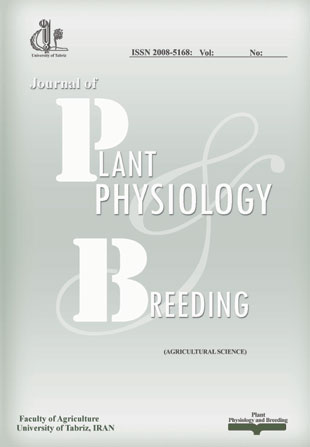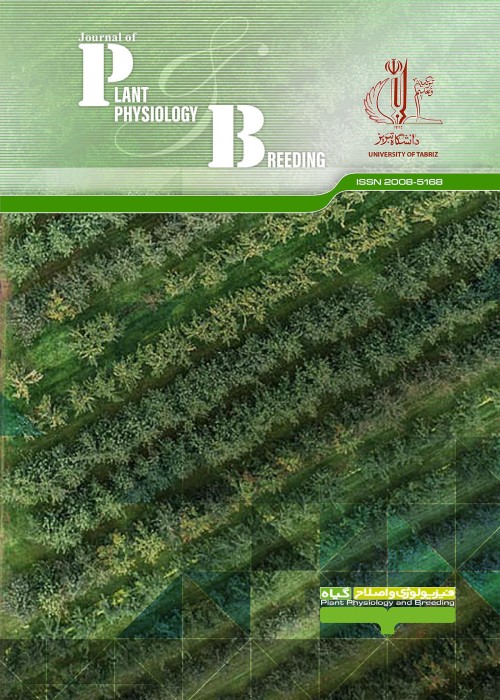فهرست مطالب

Journal of Plant Physiology and Breeding
Volume:1 Issue: 1, Winter-Spring 2011
- تاریخ انتشار: 1390/02/01
- تعداد عناوین: 7
-
-
Page 1Two experiments with factorial arrangements on the basis of randomized complete block design in three replications were conducted in 2007 and 2008, to evaluate chlorophyll content index (CCI), fluorescence of chlorophyll, proline content and grain yield of three soybean cultivars (Williams, Zan and L17) under a non-saline (control) and three saline (3, 6 and 9 ds/m NaCl) conditions in the greenhouse. Six seeds were sown in each pot filled with 900 g perlite, using 144 pots in each experiment. After emergence, seedlings were thinned and four plants were kept in each pot. Zan had the highest leaf proline content, but the lowest CCI, chlorophyll fluorescence and grain yield per plant. However, these traits were statistically similar with those of L17 and Williams. The chlorophyll content index and fluorescence of chlorophyll in soybean leaves decreased with increasing salinity. Reduction in chlorophyll fluorescence due to salinity stress was related to the damage of chlorophyll under saline conditions. In contrast, leaf proline content increased as salinity increased. Mean grain yield per plant under salinity stress was much less than that under non-saline conditions. These reductions were closely related with low CCI and PS II activity (fv/fm) and high leaf proline content in soybean cultivars. It was concluded that soybean is a sensitive plant to salinity stress, but the extent of this sensitivity varies among cultivars. Keywords: Chlorophyll content, Fluorescence, Proline, Salinity stress, Soybean
-
Page 9Effects of water stress on root and leaf growth rates and their relationships with yield under normal and water stress conditions were examined at the Greenhouse and Research Field of Faculty of Agriculture, Kerman University, Iran, using seven maize cultivars including SC-404, SC-704, BC-666, TC-647, DC-370, Jeta and Kordona. During a period of 14 days, water stress at -0.4 MPa was imposed by application of PEG-6000 to the seedlings. The root and leaf growth were measured every day. Leaf and root growth rates were expressed as the slope of the line fitted to the data of length and time. Results showed that water stress inhibited root and shoot growth in all cultivars. Differences were found among cultivars in terms of root and leaf growth rates. Differences were greater under normal compared with water stress condition. In a field experiment during 2007- 2008 growing season, yield performances of the same cultivars were measured under water stress and normal conditions. Correlation coefficients of yield with root (0.54), (0.10) and leaf (0.79), (0.32), (0.91), (0.63) growth rates were stronger under normal compared with water stress condition. Higher grain yield (mean of 10 plants per plot) of cultivars with higher growth rates under normal condition may be attributed to the higher growth rates at the early stages of growth. It could be also indicated that the higher growth rate ability of cultivars decreases when they are exposed to water stress condition.
-
Page 25Five bread wheat (Triticum aestivum L.) cultivars including Kavir, Pishtaz, Niknejad, Omid and Roshan were evaluated in a split plot experiment based on randomized complete block design with three replications. Water stress and well-watered conditions were assigned to the main plots and varieties to the subplots. Water stress was imposed by withholding irrigation at the booting stage. During a period of 45 days, which spanned before and after anthesis, plants were sampled and changes in dry matter of peduncle and penultimate internodes were assessed. An increase in grain weight was accompanied with a decrease in peduncle and penultimate internodes dry matter, which could be attributed to the remobilization of stored assimilates to grains. Remobilization of stored assimilates was relatively higher under water-stress condition as compared with the well-watered environment. Under water stress condition, tall cultivars remobilized more assimilates than the dwarf genotypes. In the well-watered plots, remobilization percentage from peduncle was more than penultimate internodes in tall varieties as compared with the dwarf varieties. On the other hand, under water stress condition, more assimilates were remobilized from penultimate than the peduncle in dwarf varieties as compared to the tall genotypes. In the dwarf genotypes assimilates remobilization was reduced under water stress conditions while it was increased in the tall cultivars.
-
Page 39In most southern provinces of Iran, soil salinity is a growing problem, particularly in irrigated agricultural areas, and has been found to reduce wheat yield, dramatically. To investigate the effect of sodium chloride on two wheat (Triticum aestivum L.) cultivars, four levels of salinity: 0, 4, 8 and 12 dS/m, were employed as a factorial experiment arranged in a randomized complete block design with four replications in a controlled environment of the greenhouse during 2006-2007. The results indicated that increasing salinity from 0 to 12 dS/m, decreased the emergence percentage significantly. Two cultivars of Kavir and Shiraz responded differently to salinity, so that Kavir showed a significantly higher emergence rate. This cultivar also had greater shoot potassium content. Number of tillers and leaves per plant and, also, plant height were decreased upon increasing salinity level. The shoot sodium content was, also increased by increasing the salinity level in both cultivars. However, sodium content of Kavir in comparison with Shiraz, was lower, probably due to Na+ exclusion mechanisms in this cultivar. The highest grain number and phytomass was obtained from Kavir at the lowest salinity level. Phytomass and grain yield were, also significantly decreased as the result of salinity. Less adverse effect of salinity on Kavir indicates that this cultivar might be suitable for saline soils, an object which worth more investigation.
-
Page 49A karyotypic study was performed on 12 Iranian local onion (Allium cepa L.) populations. A number of mitotic cells at metaphase stage for each population were prepared. Chromosomes of suitable mitotic cells were counted and various parameters, including long arm (L), short arm (S), total length of chromosome (TL), relative length of chromosome (RL), arm ratio (AR), r-value, total chromosome volume (TCV) and centromeric index (CI), were measured. All populations were diploid with 2n=2x=16 and they were differentiated by their karyotype formula and parameters. Chromosome length varied in the populations and the highest quantity of chromatinic material was found in BehdashtShahrud onion. The onion populations under study occupied classes 1A and 2A of Stebbins’ karyotype classification, indicating the presence of a primitive symmetrical karyotype in these populations. The mean chromosome length ranged from 8.54 to 11.97 µm. Haploid genome length was in the range of 67.79 to 96.65 µm and mean centromeric index (CI) of complements varied from 41.1 to 43.7%.The chromosome types were detected as mostly metacentrics “m” and some submetacentrics “sm”, showing the karyotype formula of 8m (two populations), 7m+1sm (eight populations) and 6m+2sm (two populations). The cluster analysis using chromosomal parameters and based on Ward’s minimum variance algorithm assigned the populations into two groups.
-
Page 57Determination of gene effects and combining abilities is a critical stage in maize hybrid breeding. In the present study, 20 S6 lines as female and three S6 inbred lines (K18, K19 and K1264/5-1) as tester were crossed and the resulting test cross progenies were evaluated in a randomized complete block design with three replications in 2008. During the growing period, several agronomic characters including forage yield were measured. Effects of lines and testers were significant on all the characters except ASI and days to physiological maturity for lines and ASI for testers. This indicated the importance of additive gene effect in controlling most of the traits under investigation. Inbred lines L5, L14 and L1 were identified as good general combiners for forage yield because they showed significant positive GCA for this trait. L14 was superior compared with L1 and L5 because of significant positive GCA for most of the agronomic characters. These lines, especially L14, have potential additive gene effects to be utilized in the breeding programs. T3 tester showed favorable additive gene effects for forage yield, its components, early maturity and shorter stature. The highest forage yield (79.040 t/ha) with large positive SCA belonged to L5 × T3 combination. L2 × T3 and L15 × T2 crosses were other desirable combinations. Additive genetic variance was substantially higher than dominance genetic variance for all of the traits except days to physiological maturity. This indicated that additive gene effects were more prominent than dominance effects in controlling forage yield and some other agronomic traits in relation to the studied S6 inbred lines. Therefore, narrow sense heritability estimates closely resembled the broad sense heritability values except for phenological characters. Medium to high narrow sense heritability estimates enable to select for favorable additive gene effects among the studied lines.
-
Page 69Eleven wheat cultivars were evaluated at 10-day intervals, beginning from anthesis, under irrigated and drought stress conditions during 2006-2007. The effects of irrigation, genotype and date of harvest were significant for most of the studied characters. Water deficit decreased pre-and post-anthesis assimilation rate, grain weight per spike, grain number per spike and 1000 grain weight about 5.7, 24.5, 21.2, 15.7 and 6.4 %, respectively. Mobilization, mobilization efficiency and contribution of pre-anthesis assimilates to kernels were considerably increased under drought stress condition. Grain weight, grain growth rate and contribution of current assimilates to grain filling decreased under drought stress about 7.18, 22.1 and 29.6 %, respectively. However, the effective grain filling period was considerably increased in the stressed plants. Grain filling rate was correlated with the accumulation of dry matter at maturity, grain weight per spike and grain number per spike in the irrigated and drought stressed environments (r=0.87** and 0.53, r=0.87** and r=0.62*, r=0.75* and r=0.63*, respectively). A negative correlation was found between effective grain filling period and grain yield/spike under irrigation (r =-0.65*) and drought stress (r =-0.76**) conditions. Furthermore, positive correlations between grain filling rate and grain yield were obtained in the irrigated and drought stressed environments (r = 0.87** and r = 0.62*, respectively). It seems that accumulation of pre-anthesis assimilates (mainly under drought stress), short effective grain filling period and high grain filling rate are major factors for producing higher grain yield in wheat under both irrigated and drought stress conditions.


